

19 Ancient Ruins in Arizona To Visit: A Complete Guide
Ancient ruins in Arizona are scattered all over the state. Thousands of them. You might find anything from multi-story cliff dwellings, home to a whole village, to one-room adobe homes, or just parts of a long-gone wall, even without searching.
Table of Contents
In some areas, you might find potsherds dating from thousands of years ago laying on the desert surface. All you have to do is look under your feet, no need to even dig for them.
In the desert things get preserved, baked and dried for future generations to find.
Unfortunately, as we build up our environment, fewer and fewer places like this remain untouched.
Lucky for those of us who like to see signs of ancient civilizations, the larger ruins in Arizona are protected; They are incorporated in National Parks and Monuments, State Parks, or museums. This ensures that we can visit them and learn about the civilizations that built them, people of long ago who lived in this inhospitable environment before modern amenities and air conditioning.
Exhibits in these sites also offer explanations about what happened to the people who built these ancient structures. When visiting the larger sites, we have the opportunity to learn not only about the ancient people of Arizona, but also about their descendants, the modern-day Native people of the state.
Note from the author: All the information presented in this article is a result of my multiple visits to all of the sites mentioned, and of reading about the arc h aeology of Arizona and the US Southwest for over three decades.
My Introduction to the Ancient Ruins of Arizona
The stories of the ancients, and by extension, the remains of their civilizations, the ancient ruins they left behind, are one of the reasons I live in Arizona . When I first saw Montezuma Castle , before even moving to this state, I was in awe. And I grew up surrounded by ancient structures in Transylvania . However, I’ve never seen a cliff dwelling, and I admired the ingenuity of the ancient people who built them. Even more surprising was the revelation that it was an ancient village built inside the rock.
Over time, I visited many of these sites, and I still love the chance to revisit them over and over again. Though I explored many, I know more lay hidden in the desert, sometimes in plain view in remote areas.
I came across some of these ancient ruins in Arizona, these archaeological sites in 1993, during my first visit to Arizona with my husband. Our main destination was the Grand Canyon (obviously), when we landed in Phoenix for a week-long vacation. During the heat of September, we didn’t linger in the city. Instead, we drove through Northern Arizona .
It was my introduction to the ancient ruins of Arizona and of the desert Southwest .
Over the decades, I visited many others and learned more about the people who built and inhabited them. The following list includes some of my favorite ancient ruins in Arizona.
1. Montezuma Castle
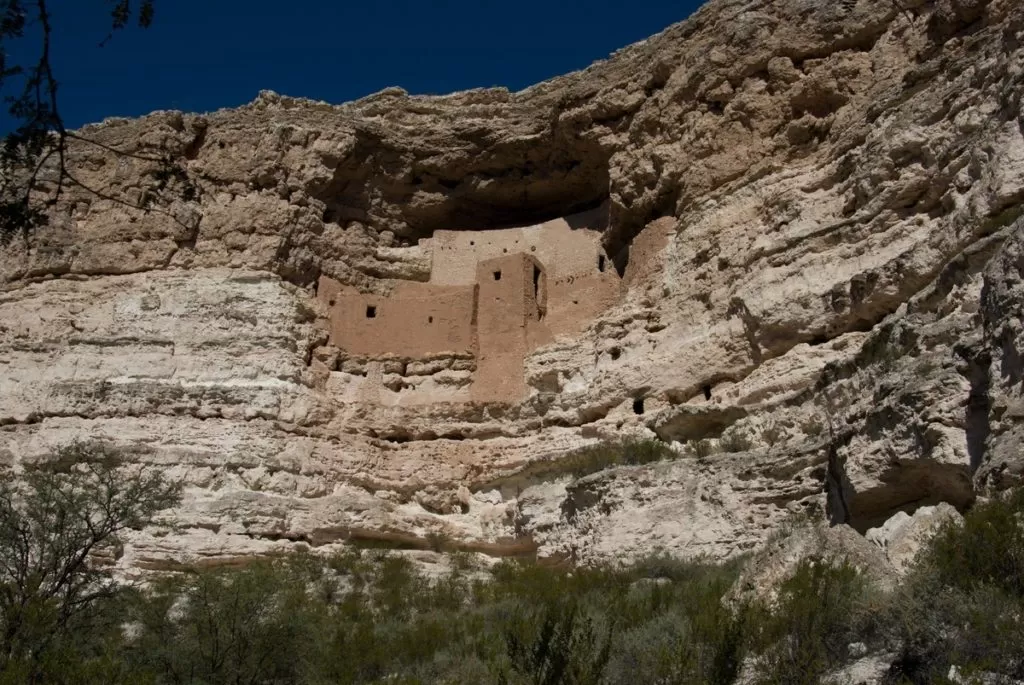
Not a castle – and definitely not built by the legendary Aztec king it got its name from – Montezuma Castle is a misnomer.
To travelers of European descent who first saw this it, the cliff dwelling looked like a castle. Since they only heard of King Montezuma, they assumed it must’ve been his.
They were wrong, of course. The people of this “castle” lived here between 1050 and 1400, a century before Montezuma was born.
Built into the limestone cliff above the trail, the 40-room towering structure is truly impressive. But rather than being a castle for an elite few, it housed a village.
Since we don’t know what the people who built this structure called themselves, we borrowed the term Sinagua (“without water”) from the Spanish explorers. It was a term they used for the San Francisco Peaks, the closest mountain range, “the mountain without water”.
When you visit the site, you’ll understand the Sinagua ingenuity. Not only did they build their home inside a cliff but they figured out how to bring water to their settlement in an arid region.
Montezuma Castle National Monument is one of the most accessible of the national parks in Arizona , and an easy day trip from Phoenix .
To get there, follow the sign from the turnoff from I-17 between Phoenix and Flagstaff. Stop at the Visitor Center first, then follow the trail in the shadow of mature Arizona sycamore trees.
2. Cliff Dwellings at Montezuma Well

Part of the same National Park, Montezuma Well , is a short drive from the cliff dwelling. Built by the same Sinagua, smaller cliff dwellings decorate the sides of the well. Other pueblo-style structures lie in its vicinity.
The well is a natural limestone sinkhole, a cenote, as they call them in Mexico. It is an unexpected sight in the high deserts of Arizona.
Offering a perfect setting for a variety of wildlife and waterfowl, the well also proved a great place for a human settlement in ancient times.
In the summer, the cold water and shade make it at least ten degrees cooler than the surrounding sun-drenched desert. No wonder the Sinagua (who were definitely not without water here) built their homes in the area.
3. Tuzigoot

Not too far from Montezuma Well, another national park , Tuzigoot preserves a different type of village built by the same Sinagua.
We don’t find cliff dwellings here. Instead, we walk through a citadel built on a hill overlooking Tavasci Marsh, a riparian area created by the Verde River.
The citadel of Tuzigoot, occupied between 1100 and 1400, housed about 250 people in about 110 rooms. It was a larger city of the Sinagua, home to more people than Montezuma Castle , or Montezuma Well .
You can reach Tuzigoot National Monument by taking exit 287 off I-17 between Phoenix and Flagstaff. From the exit, follow the signs to the National Park.
An easy day-trip from Phoenix , visiting the site offers the opportunity to drive through some of the lesser-known areas of Arizona.
4. The Cliff Dwellings of Walnut Canyon
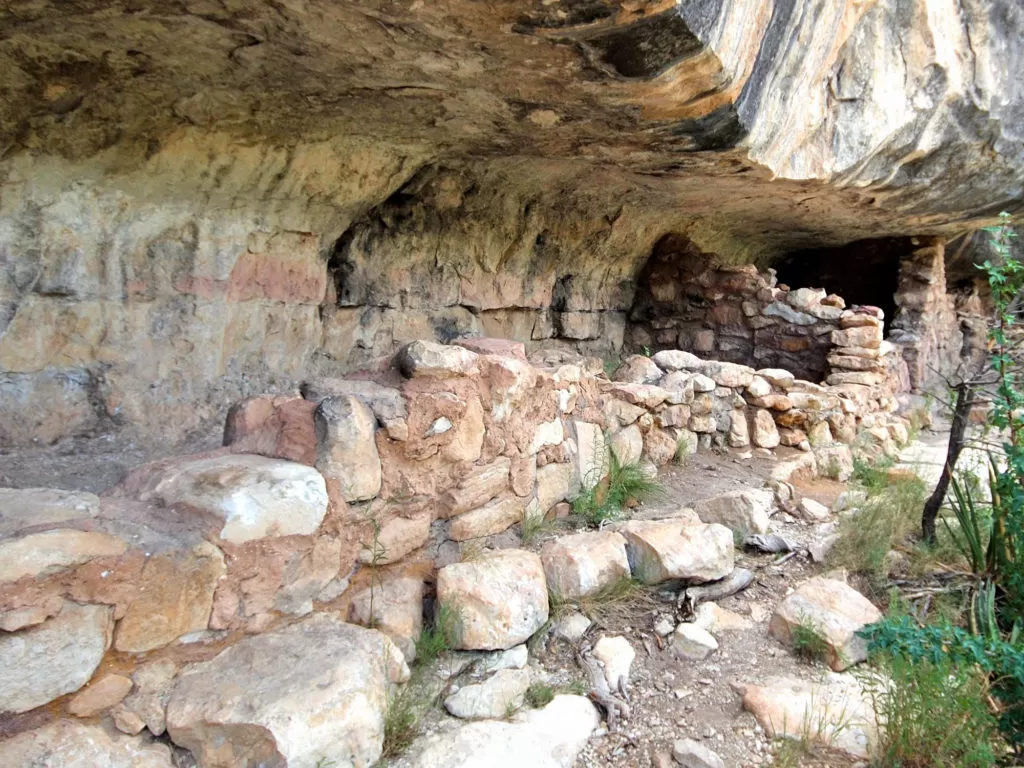
If you are looking for more cliff dwellings built by the same Sinagua, you don’t need to go far. Just east of Flagstaff, another national park unit , Walnut Canyon National Monument preserves a few more.
The Walnut Canyon community of over 100 people lived in the canyon between 1100 and 1250. They built their homes in crevices along the walls of the steep canyon, named after the Arizona black walnut trees growing on the bottom.
Walking the rim trail offers views of some of the cliff dwellings.
However, to fully enjoy and understand the site, you need to take the Island Trail. Though steep, the trail leads down halfway into the canyon, where it levels on a ledge. The ledge, wide enough to walk on – and to house these cliff dwellings – , circles the “island”. The trail on the ledge offers close views – and sometimes opportunities to walk rough – these cliff dwellings.
Walnut Canyon National Monument is only about twenty miles from Flagstaff. You can reach it either from I-40 or the historic Route 66.
The Ruins of Wupatki National Monument
Just a few miles farther, this time along I-98, you’ll reach Wupatki Ruins National Monument .
Wupatki is the largest of the ruins, but in fact, this Arizona national monument comprises a few additional ones. They were all prehistoric villages, home to ancient Pueblo people, ancestors of the modern Pueblo people, the Hopi and Zuni among them.
5. Wupatki Pueblo
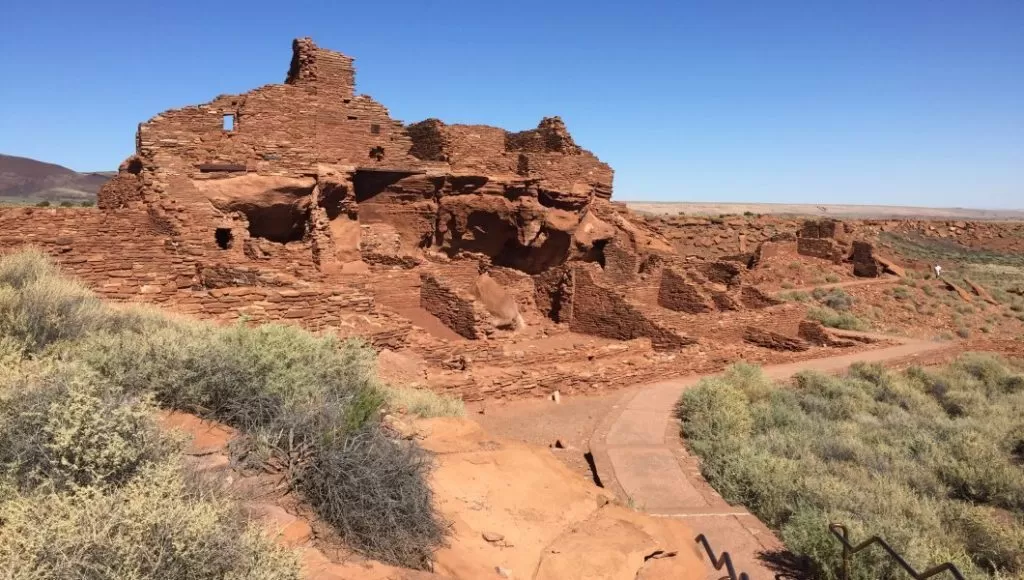
Wupatki is the largest ruin at the site, and this is where you’ll find the Visitor Center of the national monument.
Though you can walk out onto the trail from the parking lot, your tour of the ruins should start inside the Visitor Center. Th museum on the premises offers a great introduction to the site, and an insight into the lives of the Pueblo people who built it.
From there, take the trail through the site. Stop at the overlook for an encompassing view of the ancient village. Then walk along the trail to the Tall House, a spectacular four-story structure, the largest free-standing pueblo structure in Northern Arizona. Built and occupied between 1100 and 1185, it was home to about 100 people. Follow the trail to a great kiva, sit down inside it, and enjoy the surroundings. Then walk farther down the trail to the ancient ball court.
6. Wukoki Pueblo

Perched on top of a large sandstone rock, Wukoki Pueblo is an eight-room structure. Built and lived-in between the early 1100s and mid-1200s, now stands partially preserved, waiting for visitors. Fewer people stop here than at Wupatki Pueblo – for good reason – , however, the site is still worth a short visit. The trail is only 0.2 miles long, and here you can walk into the structure.
7. Citadel and Nalahiku Pueblos
Just off the road, reachable from a pullout, Citadel Ruins preserve a large structure. You’ll reach Nalahiku Ruins, a smaller sandstone structure at the start of the trail. Follow the trail past it, to reach Citadel Pueblo, on top of a small hill. These sites date from around 1190.
You can hike up to the top of the hill to Citadel and enjoy beautiful vistas of the Painted Desert in the distance. Be aware that it is usually (every time I visited) very windy on top of Citadel Ruins.
You’ll find Wupatki National Monument , home to all of the above ruins, on the Sunset Crater and Wupatki Scenic Road , just northeast of Flagstaff, off the US-89 N.
8-9. Betatakin and Keet Seel
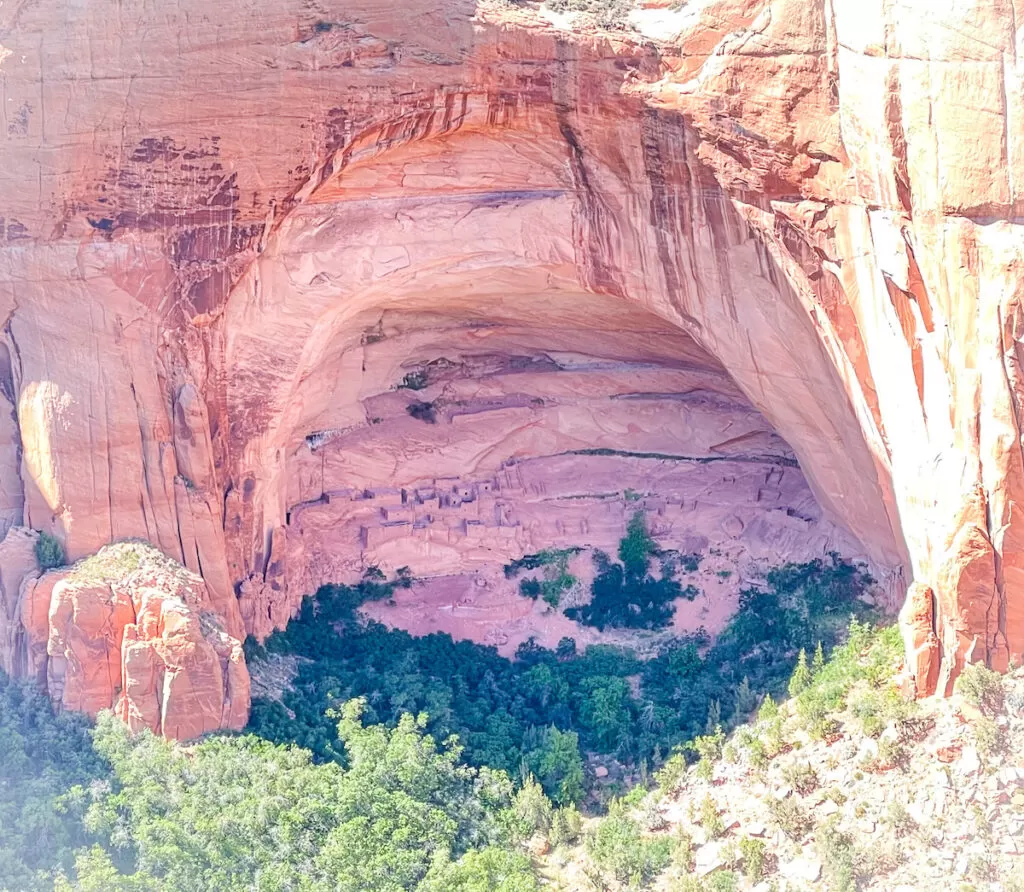
On the Navajo Reservation, in the Four Corners Region , you’ll find some of the most impressive cliff dwellings in Arizona, Betatakin and Keet Seel.
Although they are fully on the land of the Navajo Nation, they are preserved as part of a national park unit of Arizona , called Navajo National Monument .
To get there, you’ll drive through the Painted Desert, and marvel at the colors of the surrounding rock formations. You’ll pass tiny settlements and dirt roads leading seemingly nowhere. This Dinétah, the land of the Navajo Nation.
Long before the Diné came to live in the area, this landscape was home to the Ancestral Pueblo people, known as the Anasazi for a long time, a term borrowed from Navajo, meaning “the ancient ones”.
The Ancestral Pueblo people built Betatakin, Keet Seel and Inscription House in the sandstone alcoves of the canyon. They lived here around 1250 to 1300, but in this short time they left behind some of the best-preserved ancient ruins in Arizona.
You can see the impressive cliff dwellings of Betatakin from the Sandal Trail along the rim. However, for a closer look you need to join a guided tour. They start in the morning, so your best bet is to camp there if you want to do it.
Navajo National Monument is on the Navajo Reservation, you can reach it from a turn-off from US-89 N.
Ancient Ruins in Canyon de Chelly
One of my favorite sites in Arizona, Canyon de Chelly has some of the most spectacular cliff dwellings in the Four Corners area.
It is a place I visit often with my family. Over the years, we hiked inside the canyon with a guide , took our own four-wheel-drive with another local guide, and often hiked the trail to White House Ruin on our own.

10. White House Ruins
T he best-known cliff dwelling in the park, White House Ruin, at then end of a well-traveled trail, is visible from the canyon top. Though you can no longer hike on a self-guided tour, you can join a ranger-led tour to get to it. These tours are offered at the Visitor Center.
The name White House comes from the white plaster still visible on the back wall of the upper part of the cliff dwelling. Scholars believe that it was home to about 100 people between around 1060 and 1275.
11. Mummy Cave
You can see the cliff dwellings in Mummy Cave from the overlook in Canyon del Muerto, about ten miles east of White House Ruin.
Featuring about 70 rooms and three kivas, the site was once home to about 60-75 people. They lived there from about 600 CE to 1275.
12. Antelope House Ruins
Antelope House Ruins are cliff dwellings along the sides of Canyon del Muerto as well, visible from another overlook.
Though a glimpse from the overlooks are a great way to see these ruins, you can get closer to them if you hire a local guide. They offer either hiking or driving tours to the sites.
Canyon de Chelly National Monumen t is on the Navajo Reservation, and you can reach it via I-40.
Note: The White House Overlook Trail is closed (in May 2023) because of safety concerns.
13. Cliff Dwellings in Tonto
You can find more cliff dwellings in Arizona much closer to Phoenix, at Tonto National Monument , in Roosevelt, Arizona.
Two sets of cliff dwellings are at this site, though only the Lower Cliff Dwelling is open for a self-guided visit. For the Upper Cliff Dwelling, you need to join a ranger-led tour.
A small group of a prehistoric cultural group called Salado built them around the year 1300. This group, living in the Tonto Basin between 1250 and 1450, was a mix of a few individual groups who migrated here over a few centuries.
The Hohokam, or Ancient Sonoran Desert People from the Phoenix area settled here around 700 CE and mixed with the local population. Later, around 1100-1500 CE Ancestral Puebloans arrived, followed by Mogollon groups from the region.
Eventually, all these people, several thousands of them, created their own culture, called the Salado Culture, from the mix of the individual ones.
14. Besh Ba Gowah
Another site left behind by the ancient Salado People is only a few miles past Tonto, in the small town of Globe. The archaeological site features partially reconstructed ruins built between 1225 and 1400.
A small museum at the site showcases prehistoric pottery, textiles, and stone objects used by the Salado People archaeologists found on the premises.
The ancient village known as Besh Ba Gowah borrowed its name from the Apache term for the early settlement, meaning “place of metal”.
Once home to one of the largest and most complex Salado Community, the site had about 400 rooms on two levels.
15. Casa Grande
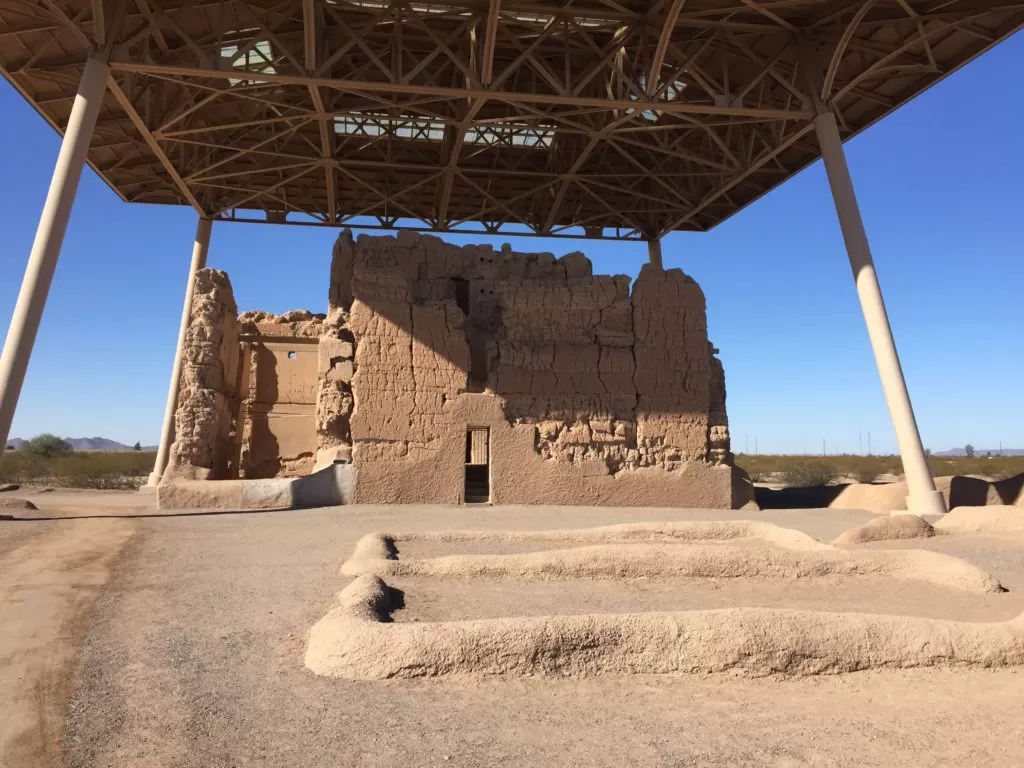
About an hour’s drive from Phoenix, perfect for a day trip visit, another national park unit preserves the ruins of Casa Grande , a prehistoric village of the Ancestral Desert people also known as Hohokam.
Dominated by the four-story “big house” that gave the site its name, the site was not only a village but also a ceremonial and trading center.
You can learn about the people who built it and lived in it when you visit the museum at the Visitor Center. From there, walk along the trails and around the buildings surrounding the “Big House”. People lived in this area, and built the village between 1100 and 1450. The largest structure, Casa Grande, the big house the site got its name from, dates from the 1300’s.
You can reach Casa Grande Ruins National Monument from Phoenix in a few different ways, driving towards Florence.
16. S’edav Va’aki Museum and Archaeological Site

Sitting in the center of Phoenix, S’edav Va’aki Museum preserves the ruins of the same people, also nicknamed the “canal makers” who lived in this place thousands of years before us.
The archaeological site features a pit house that answers the question we often ask ourselves: how could these people live here in the heat of the desert.
The answer is, they invented air conditioning of sorts. By building the pit house partially underground, they kept it cooler in the summer months and warmer in the winter.
You won’t notice it at first glimpse though, but if someone points it out to you, you’ll have one of those aha moments.
A desert garden irrigated the way the ancients would have, a ball court and a newer complex of pit houses sit along the trail.
At the far end, you’ll see the Phoenix canal we still use, originally dug by the people who built the ancient city. Nicknamed the canal makers, they built miles upon miles of them, bringing water to the far sides of the Valley of the Sun, to what is today Glendale.
S’edav Va’aki Museum Archaeological Park is only a few minutes from the airport, and it is a perfect stop on a long layover even to those just passing through Phoenix.
17. The Sears-Kay Ruins

A more remote – and much smaller – site in Arizona, the Sears-Kay ruins was an ancient village built by the same Ancestral Sonoran Desert People (Hohokam) who lived in and around ancient Phoenix. You’ll find it in the desert just east of the city, on the scenic drive towards Seven Springs.
Remains of a prehistoric hilltop village, the Sears-Kay ruins comprise 40 rooms in five separate compounds. Dating from around 1050 to 1200, this ancient village is only one of a few built in the foothills surrounding Carefree.
Protected by stone walls, it stood on a prominent hilltop and seemed to be built for defense. Archaeologists think this shows competition for resources, possibly land and water. The general thinking is that they were meant to protect the foothills from outside attacks.
At the end of a half-mile trail through the desert, you’ll reach the ruins, comprising above-ground rectangular structures.
The largest, most complex one was once a fortified hilltop compound, built on two levels, on the very top of the hill. It is not only the largest structure, but has the farthest view of the area. This might suggest that the entire village used it in times of danger, when they might have been attacked.
By the end of the 12th century the Hohokam abandoned the village, moving down into the valleys, in less defensive locations.
18. Shoofly Village Ruins
Another small site, just outside of Payson, on the Mogollon Rim, Shoofly Village Ruins preserve the vestiges of another ancient settlement.
You won’t find spectacular structures here, though the views are gorgeous, overlooking the Rim and its pine-covered forests.
You’ll see the base of many ancient homes here, built by the ancient Mogollon Rim People between 1000 – 1250 AD. At its busiest time, the village was home to about 250 people, living in around 80 one-room homes with courtyards and plazas.
The ancient village was surrounded by a stone wall, the remains of which you can still see.
Looking out from the trail, you have perfect views of the Mogollon Rim, and you realize that its gorgeous setting must have been the reason the ancients choose the location for this village.
19. Puerco Pueblo in Petrified Forest

Though famous for its petrified wood, Petrified Forest National Park is also home to ancient ruins.
Thousands of them are scattered through the area, ranging from one-room shelters to pueblos with over a hundred of them.
One of these sites you can visit in the park is Puerco Pueblo, an ancient village that once housed about 200 people. Built on the banks of the Puerco River, the village was home to the Ancestral Puebloans between 1250 – 1380 AD.
A 0.3-mile trail takes visitors through the site, to see remains of the walls of the rooms, and a few clearly discernible petroglyphs.
And You Can Find Many More…
The above list only highlights a few of the ancient ruins or archaeological sites in Arizona. However, the state is full if ancient dwellings, villages on hilltops, near washes, or anywhere people could survive.
When you hike in the desert, you’ll often find ruins, or broken pottery in the most unexpected places, often without any signs to tell you about them.
For those interested in these sites, it’s worth exploring non-designated trails in the desert. Especially if you notice a trail of broken pottery along them, or unnatural-looking piles of rocks.

Recently, my husband and I hiked one of these trails. The scenery was gorgeous, and on top of the hill, we found a few ancient walls.
But what was even more amazing for me were the pottery pieces scattered nearby. Finding them as I looked under my feet made me feel like an explorer, an archaeologist.
To give the next person the same feeling, the same sense of wonder, please leave them as you find them.
Q &A: In a Nutshell about the Ancient Ruins of Arizona
Are there ancient ruins in arizona.
Arizona is filled with ancient ruins. You can find them everywhere, from the center of Phoenix to the farthest parts of the state, both southeast and the northeast. Some are large, and well preserved, others just barely walls in the middle of the desert.
What type of ruins can you find in Arizona?
You can find both cliff dwellings and pueblo-style structures built of stone or clay.
What are cliff dwellings?

Who built the ancient structures in Arizona?
Different ancient people of the desert built the ruins in Arizona. The cliff dwellings and stand-alone structures in central Arizona, Montezuma Castle and Montezuma Well, Tuzigoot, and Walnut Canyon are the work of ancient people we call Sinagua. The Ancestral Puebloans, known for a long time as Anasazi built the cliff dwellings and structures in the northern part of the state, in Canyon de Chelly, Wupatki and at Navajo National Monument. The people who built the structures in today’s Phoenix, and its vicinity, Pueblo Grande and Casa Grande, are the Ancient Sonoran Desert people, also known as Hohokam. The ruins in the southeastern part of the state, Tonto and Besh Ba Gowah, are the work of ancient people belonging to the Salado Culture.
What happened to these ancient people?
Contrary to the old belief, people who built these structures did not vanish, did not disappear. They are the ancestors of the present-day modern Indigenous nations of Arizona. For example, the Hopi and Zuni tribes trace their lineage to the Ancestral Puebloans. You can learn about their stories when visiting the specific archaeological sites, or the Heard Museum in Phoenix.
Recommendations and Resources
Affiliate Disclosure: Some of the links below are affiliate links. This means that if you make purchases or bookings through my affiliate links, I may earn a small commission, with no additional cost to you. However, it may help me offset the costs associated with running this site. Please read our disclosure policy for more information. Thank you! Read more about your destination, and use guidebooks when you go: Carrying a physical book with you might be old-fashioned, but in a world where cell service is spotty or nonexistent, it pays to do so. The Lonely Planet guide books are my go-to travel books. Try the Southwest USA Travel book (or ebook ) for information on the better-known of the above sites. *If buying a book through my link, a 10% discount will be automatically applied to your purchase (but if you don’t see the discount, use coupon code EMESEFROMM10) Book your flight: Unless you live within driving distance from these sites, you need to fly to Phoenix. Check several different sites to find the best deals. Unless you know what airline you are using use (and have a credit card with points from that airline), you could check CheapOair and WayAway for deals. Book your rental car: To compare prices of different car rental companies, Discover Cars is a great place to start. Or, use RentalCars.com . Book your accommodations: You can use Trivago to compare deals on hotels and alternative accommodations. Or, book a place through Booking.com .
About the author
Emese-Réka Fromm is a resident of Arizona for over thirty years. Interested in archaeology and the history of ancient people, she often explores ancient ruins in Arizona with her husband. She also reads professional books about the sites she visits. Published travel writer with bylines is publications like Lonely Planet, Matador Network, Travel Awaits, among others, she is also traveler and language instructor in Phoenix.

13 Historical Landmarks You Absolutely Must Visit In Arizona

Monica Spencer
Monica is a Diné (Navajo) freelance writer and photographer based in the Southwest. Born in Gallup and raised in Phoenix, she is Tódich'ii'nii (Bitter Water People) and Tsi'naajinii (Black Streak Wood People). Monica is a staff writer for Only In Your State, photo editor for The Mesa Legend, and previously a staff writer for The Navajo Post. You can reach her at [email protected].
More by this Author
Arizona has no shortage of historical sites that make Arizonans proud. In fact, did you know our state has a whopping 45 national historical landmarks? Today, we’re going to take a look at just 13 of those sites and hopefully it will entice you to visit one of these places in the near future.
Please note, Hubbell Trading Post and Pueblo Grande Museum are temporarily closed.
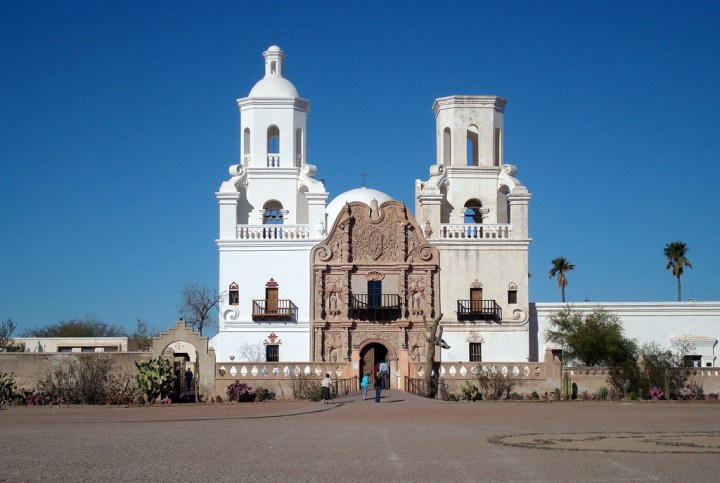
Related Stories
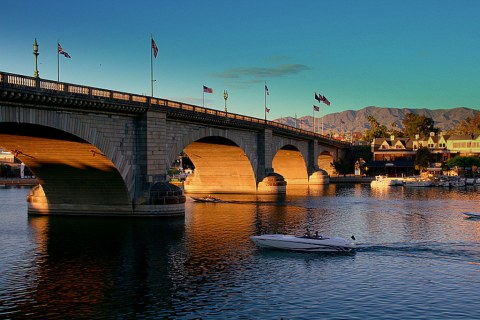

The History Behind This Arizona Bridge Is Truly Strange
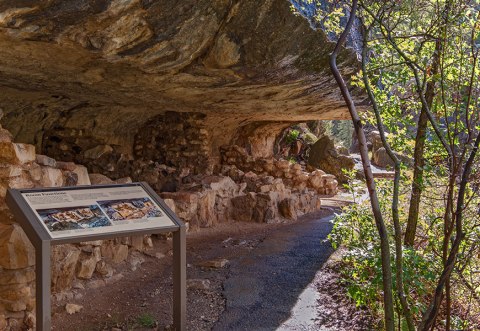
You Can Easily Visit These 3 National Monuments In Arizona Before Dinner
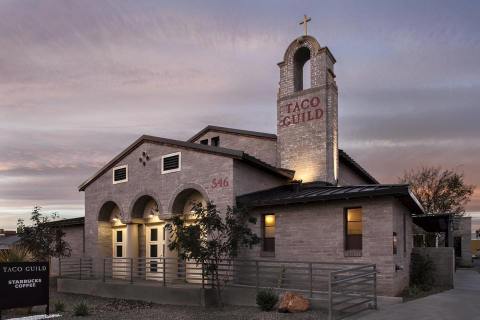
This Restaurant In Arizona Used To Be A Church And You’ll Want To Visit
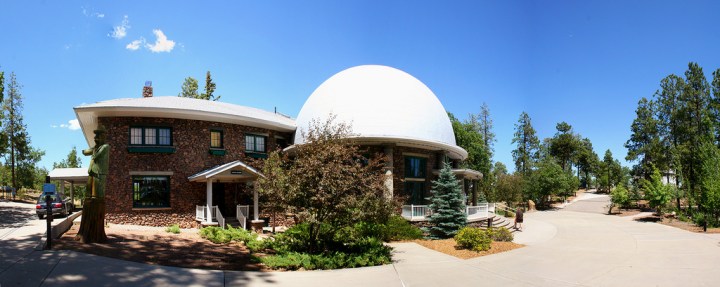
Have you visited any of these national historical landmarks before? Don’t forget to let us know your thoughts!
OnlyInYourState may earn compensation through affiliate links in this article. As an Amazon Associate, we earn from qualifying purchases.
Want more Arizona in your inbox?
Get the latest on things to see, do, and eat around Arizona!
Thank you! You'll receive your first newsletter soon!
An error occured.
Related Articles
- You'll Never Forget A Visit To One Of The Oldest Towns In Arizona
- The Chapel In Arizona That’s Located In The Most Unforgettable Setting
- Most People Don’t Know About The Mystery Castle In Arizona And It’s Truly Enchanting
- You’ll Never Forget A Visit To This Alluring Castle In Arizona
- Here Are The 12 Oldest Towns In Arizona...And They're Loaded With History
- Most People Don't Know These 10 Hidden Gems In Arizona Even Exist
- You’ll Want to Cross These 10 Amazing Bridges In Arizona
- These 15 Churches in Arizona Will Leave You Absolutely Speechless
Explore Arizona
- Arts & Entertainment
- Farms & Wildlife
- Fun Adventures
- Shops & Boutiques
- Sights & Landmarks

Guide to Arizona National Monuments: 18 Magnificent Places (without crowds!)
This post contains affiliate links. If you use these links to buy something we may earn a commission at no extra charge to you.
Last Updated on April 11, 2023
The Grand Canyon is great, but aren’t there some off-the-beaten-path historic sites and parks?
Visiting Arizona National Monuments is a terrific way to see the beauty of the state, often with only a fraction of the visitors at Arizona National Parks . National Monuments in Arizona range from areas with unusual geological formations to sights of historic (and prehistoric!) significance. In total there are 18 Arizona National Monuments, more than any other state. Most of these sites are managed by the National Park Service and have services such as interpretive centers, ranger-guided programs and restrooms. Visiting National Monuments in Arizona provides an opportunity to explore the state’s unique scenery and culture without the crowds that can clog up the more well-known National Parks.
To help you understand the many options available to you while traveling in Arizona, we’ve outlined some of the guidelines that distinguish Arizona National Parks from Arizona National Monuments, as outlined by the National Park Service . We’ve also listed all 18 designated National Monuments in Arizona, with the services available at each. Be sure to include a visit to these magnificent sites on your next trip–you won’t be disappointed!
PRO TIP: A road trip is a great way to see Arizona National Monuments. Check out our 11 favorite Arizona road trips for some ideas and inspiration!
Click Here to see Table of Contents ➤
Fast facts about Arizona National Monuments

What IS a National Monument?
National monuments are areas reserved by the Federal Government because they contain objects of historic, prehistoric, or scientific interest. Among National Monuments in Arizona you’ll find ancient cliff dwellings, archeological ruins and natural areas with unusual landscapes and rock formations.
What is the difference between a National Park and a National Monument?
National parks are areas set apart by Congress for the use of the people of the United States generally, because of some outstanding scenic feature or natural phenomena (hello, Grand Canyon!). National monuments are generally smaller than National Parks, focusing on a single unique feature. Although some Arizona National Monuments are quite large; Organ Pipe Cactus NM is over 500 square miles.
How many National Monuments in Arizona are there?
Arizona has 18 sites designated as National Monuments, more than any other state.
Who manages Arizona National Monuments?
Most National Monuments in Arizona are managed by the National Park Service. A few sites are managed by the Bureau of Land Management. Occasionally sites will be managed by local authorities, either alone or in conjunction with a federal agency.
Complete list of National Monuments in Arizona
PRO TIP: Opening times and certain park services may be limited due to COVID-19 restrictions. Be sure to check with each park prior to visiting.
Agua Fria National Monument
A large area of preserved mesa and canyon along the Agua Fria River. Varying altitudes provide a wide range of desert vegetation, and there are some petroglyphs among the rocky canyon.
- Location: Central Arizona
- Type of Site: Natural Landscape, Ancient Culture
- Services: None-Bring in and take out all supplies
- Special Considerations: 4-wheel drive not necessary, but advised

Canyon De Chelly National Monument
A fantastic place to observe dramatic scenery with over 5,000 years of continuous habitation. Some descendants still live on the site (a rarity among national sites). Scenic drives provide magnificent vistas, up-close views of the cliff dwellings are with local guides.
- Location: Northeastern Arizona
- Type of Site: Ancient Culture with cliff dwellings
- Services: Visitor Center, Guided tours, Accessible paths
- Special Considerations: Located on Navajo Nation lands, which observe Mountain Time Zone schedules

Casa Grande Ruins National Monument
Ruins of a large structure dating back to the 1400s from a Sonoran Desert agricultural society. Its exact purpose is unknown, but the scale of the remains attest to the sophistication of the community.
- Location: Central Arizona (between Phoenix & Tucson)
- Type of Site: Ancient cultural ruins
- Services: Guided tours, gift shop, picnic grounds
- Special Considerations: Accessible pathways

Chiricahua National Monument
Wonky, other-worldly rock formations that go on for miles make great atmosphere for hiking or a scenic drive. Chiricahua is located along a North American flyway and is a good site for birders.
- Location: Southeastern Arizona
- Type of Site: Natural Landscape, geological wonder
- Services: Visitor center with museum, bookstore, restrooms, drinking water
- Special Considerations: camping at Bonito Canyon , Birding

Grand Canyon-Parashant National Monument
Parashant is one of the Arizona National Monuments that is vast, wild and absolutely gorgeous. This million-square-mile area on the northern side of the Grand Canyon is completely “off the grid,” with no services. There’s plenty of room to roam, but you MUST have a 4-wheel drive vehicle, preferably with high clearance.
- Location: Northern Arizona, along the border with Utah and Nevada
- Reason to visit: Stunning scenery
- Facilities & Services: No services within the monument boundaries; there is an information center in St. George, Utah
- Special Considerations: 4-wheel drive required; although located in Arizona, entrances are from either Nevada or Utah.

Hohokam Pima National Monument
Hohokam Pima National Monument celebrates an ancient people that thrived during the first millennium. Excavations of an ancient site are ongoing and closed to the public, however there is much to learn about the community at the Huhugam Heritage Center, which showcases precious ancient artifacts discovered at the archaeological site.
- Location: Central Arizona, about 20 miles south of Phoenix.
- Type of Site: Ancient culture, museum & heritage center
- Facilities & Services: Visitor center/museum, restrooms.
- Special Considerations: Managed by Gila River Indian Community; hours may be different to other national sites

Ironwood Forest National Monument
A large (129,000 acres) site that offers plenty of wide-open desert spaces for solitude and exploration. There are 3 designated National Historic archaeological sites within the boundaries for the truly intrepid.
- Special Considerations: Camping and hunting allowed

Montezuma Castle National Monument
Stunning 600-year-old cliff dwelling that is remarkably intact. The 40-50 room structure is only viewable from a distance to preserve it. There is a smaller dwelling about 10 miles away, known as Montezuma Well, that is also part of the Monument. Although not as grand, it allows for a more up-close view of the structure.
- Type of Site: Ancient culture; cliff dwellings
- Services: Montezuma Castle has a Visitor Center, with museum, bookstore and restrooms, along with picnic grounds. Montezuma Well has picnic grounds and pit toilets.
- Special Considerations: Two sites, about 10 miles apart, comprise the Monument
- NOTE: See our separate (and more detailed) posts about Montezuma Castle & Montezuma Well

Navajo National Monument
Spectacular cliff dwellings from the 1300s set in a massive red rock cave. Long-distance views by walkway with limited wheelchair accessibility. Close-up views of the cliff dwellings by guided tour only, rugged terrain.
- Location: North Central Arizona
- Type of Site: Ancient culture, cliff dwellings
- Services: Visitor Center, with museum, bookstore and restrooms, ranger-guided tours of the cliff dwellings, camping

Organ Pipe Cactus National Monument
The unique desert landscape at Organ Pipe has been designated an International Biosphere Reserve by the United Nations. This Arizona National Monument is large and uncrowded: at over 500 square miles it’s over 3 times bigger than Saguaro National Park, yet it receives only 1/4 of the visitors. There are plenty of hikes and scenic drives; Organ Pipe Cactus National Monument is well worth a trip to southwestern Arizona.
- Location: Southwestern Arizona
- Type of Site: Natural Landscape
- Services: Visitor center with displays, bookstore, restrooms; scenic drives, hiking trails, RV and tent campsites, backcountry camping
- Special Considerations: hike to an abandoned mine on monument grounds, or take the Ajo Mountain Drive for terrific views of the namesake cacti.

Pipe Spring National Monument
The homestead at Pipe Spring offers a glimpse into the rugged life of Mormon homesteaders in the late 1800s. The fresh water from the Pipe Spring has attracted settlers for centuries; there is an interesting perspective on both Native American and White inhabitants of the area. Not many Arizona National Monuments grow fresh fruits and vegetables–the National Park Service still maintains the gardens (and livestock!) at Pipe Spring.
- Location: Northwestern Arizona
- Type of Site: Historic homestead
- Services: Visitor Center with museum, bookstore, restrooms; historic ranch with animals, fresh heirloom fruits and vegetables (in season)

Sonoran Desert National Monument
A great National Monument in Arizona if you want to spend time exploring the Sonoran Desert landscape on your own, at your own pace. Camp out under the stars . . . and even bring your horse if you’d like to ride! This is one of the few national monuments that allows hunting on the grounds.
- Location: South Central Arizona
- Services: Limited restroom facilities
- Special Considerations: In addition to camping, hunting and horseback riding are allowed

Sunset Crater Volcano National Monument
Visit the cinder cone of an extinct volcano at Sunset Crater. Even a thousand years (!) after it last erupted, the terrain is still barren near the top. You can also hike the area of the former lava floes–an other-worldly experience if there ever was one. Those with mobility issues can view the terrain via scenic drives.
- Location: North central Arizona
- Type of Site: Geological wonder
- Services: Visitor Center, restrooms, picnic grounds, campgrounds
- Special Considerations: Admission fee also covers access to Wupatki National Monument, 20 miles away.

PRO TIP: Plan to visit Sunset Crater and Wupatki National Monuments on the same day. They are only 20 miles apart and the admission fee gets you into both sites!
Tonto National Monument
There are a LOT of cliff dwellings in Arizona; Tonto is special among Arizona National Monuments in that you can walk right up and into the dwellings themselves. There are two sites: the lower dwelling is accessed via a paved path; see the upper dwelling via a ranger-guided tour over rugged terrain. The central Arizona location makes it a nice day trip from Phoenix.
- Type of Site: Ancient cliff dwellings
- Services: Visitor Center, museum, restrooms, picnic grounds, guided tours
- Special Considerations: trail to the lower cliff dwelling is paved, but is steep, with some steps, so might not be suitable for those with accessibility concerns

Tuzigoot National Monument
Tuzigoot is the remains of a 1,000-year-old Sinagua pueblo perched on a ridge overlooking the Verde River. The complex of 100+ rooms illustrates the sophistication of this society–modern-day condos could borrow a few tips from the construction here! This is one of the Arizona National Monuments that is nearby Sedona, making a nice excursion if you’re in the area.
- Type of Site: Ancient Culture
- Services: Visitor Center, museum, bookstore, restrooms, picnic grounds
- Special Considerations: There are paved trails to the base of the pueblo and along the marsh; access inside the upper rooms requires stairs.

Vermilion Cliffs National Monument
Vermilion Cliffs is a great place to go if you like eerie rock formations. This National Monument has no services, so be prepared to rough it. But you’ll be rewarded with solitude and stunning scenery.
- Location: Northern Arizona
- Type of Site: Geological Wonders
- Services: None-bring in and take out everything
- Special Considerations: 4-wheel drive required

Walnut Canyon National Monument
Walnut Canyon’s cliff dwellings more hidden than those at the other Arizona National Monuments. They are tucked away along a ridge in the forest, largely hidden from view until you are right on top of them. But that’s part of their charm: you can walk right up–and into–them, giving you an ancient’s-eye-view of life in what would become Arizona in about 500 years.
- Services: Visitor Center, museum, bookstore, restrooms
- Special Considerations: Path to the cliff dwellings involves climbing up and down stairs

Wupatki National Monument
If you like ancient pueblo construction, you get a lot of bang for your buck at Wupatki. The area encompasses six distinct pueblo structures out on an open plain over an area of about 15 miles. Drive from pueblo to pueblo via a loop road, then take short paths to the structures themselves. Among Arizona National Monuments, this is an excellent option for those with mobility issues. Paths to 4 of the 6 pueblos meet accessibility standards, the accessible path to the remaining pueblos is currently under construction.
- Services: Visitor Center, museum, restrooms
- Special Considerations: Admission fee also covers access to Sunset Crater National Monument, 20 miles away.

Now that you’ve seen the stunning array of choices to visit at Arizona National Monuments, which one will you visit first?
Some of our most popular posts
- 7 Tips to Avoid Scams on Airbnb & Other Popular Vacation Rental Sites
- A Fun Visit to the Massive Tucson Airplane Graveyard (AKA “The Boneyard”)
- Standing on the Corner Winslow Arizona: Visiting a Memorable Rock n’ Roll Park
IF YOU LIKED THIS POST PLEASE SHARE TO ONE OF YOUR PINTEREST BOARDS

You might also like

This site uses cookies. By continuing to browse the site, you are agreeing to our use of cookies.
Cookie and Privacy Settings
We may request cookies to be set on your device. We use cookies to let us know when you visit our websites, how you interact with us, to enrich your user experience, and to customize your relationship with our website.
Click on the different category headings to find out more. You can also change some of your preferences. Note that blocking some types of cookies may impact your experience on our websites and the services we are able to offer.
These cookies are strictly necessary to provide you with services available through our website and to use some of its features.
Because these cookies are strictly necessary to deliver the website, refuseing them will have impact how our site functions. You always can block or delete cookies by changing your browser settings and force blocking all cookies on this website. But this will always prompt you to accept/refuse cookies when revisiting our site.
We fully respect if you want to refuse cookies but to avoid asking you again and again kindly allow us to store a cookie for that. You are free to opt out any time or opt in for other cookies to get a better experience. If you refuse cookies we will remove all set cookies in our domain.
We provide you with a list of stored cookies on your computer in our domain so you can check what we stored. Due to security reasons we are not able to show or modify cookies from other domains. You can check these in your browser security settings.
We also use different external services like Google Webfonts, Google Maps, and external Video providers. Since these providers may collect personal data like your IP address we allow you to block them here. Please be aware that this might heavily reduce the functionality and appearance of our site. Changes will take effect once you reload the page.
Google Webfont Settings:
Google Map Settings:
Google reCaptcha Settings:
Vimeo and Youtube video embeds:
You can read about our cookies and privacy settings in detail on our Privacy Policy Page.

IMAGES
VIDEO
COMMENTS
Historic Sites In Arizona includes fascinating exhibits, incredible monuments, iconic figures, legendary trails, and so much more.
Arizona is filled with ancient ruins. You can find them everywhere, from the center of Phoenix to the farthest parts of the state, both southeast and the northeast. Some are large, and well preserved, others just barely walls in the middle of the desert.
Arizona has no shortage of historical sites that make Arizonans proud. In fact, did you know our state has a whopping 45 national historical landmarks? Today, we’re going to take a look at just 13 of those sites and hopefully it will entice you to visit one of these places in the near future.
Top Arizona Landmarks: See reviews and photos of sights to see in Arizona on Tripadvisor.
Visiting Arizona National Monuments is a terrific way to see the beauty of the state, often with only a fraction of the visitors at Arizona National Parks. National Monuments in Arizona range from areas with unusual geological formations to sights of historic (and prehistoric!) significance.
Famous landmarks in Arizona range from world-renowned sites, like Antelope Canyon, to places of cultural interest, like Taliesin West. If you're still wondering what to see in Arizona, read on for 35 of the Grand Canyon State's most incredible attractions!